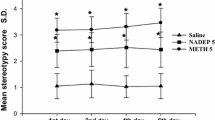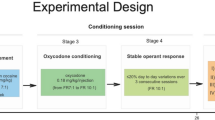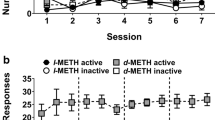Abstract
In the present study the drugs (Methaqualone + diphenhydramine or Methaqualone alone) were administered daily in a liquid diet to different groups of rats for 3 weeks. Each week the doses of the drugs were increased and daily records of body weight, mean rectal temperature and spontaneous motor activity (SPM) were maintained. During the first week, tolerance to both the drugs was observed when the animals received 152.4 mg/kg-1/day of methaqualone (MQ) and 140.0+14.0 mg/kg-1/day of methaqualone + diphenhydramine (MQ+D) respectively. In the second week the doses were further increased to 302.0 mg/kg-1/day of MQ and 277.8+27.7 mg/kg-1/day of MQ+D respectively.
At the end of the second week complete tolerance developed to increased doses of MQ but not to the MQ+D combination. In the third week the doses were further increased to 406.6 mg/kg-1/day of methaqualone and 383.4+38.3 mg/kg-1/day of MQ+D respectively. At the end of this week although there was partial recovery but, compared to the controls, a significant lowering (P<0.05) of mean rectal temperature and spontaneous motor activity persisted in both groups thus showing an incomplete tolerance to larger doses of both MQ and the MQ+D combination. When the drugs were withdrawn after the third week, both MQ as well as MQ+D treated groups of rats exhibited an increased susceptibility to audiogenic stimuli of, but MQ+D treated animals showed an even greater susceptibility to such stimuli and also a fall in body weight. Further, 50% of rats in MQ+D group died during convulsions while there were no deaths in the group treated with MQ alone. The results of this study suggest that the MQ+D combination causes a more severe degree of physical dependence than MQ alone.
Similar content being viewed by others
References
Agarwal, A. K., Singh, N., Kohli, R. P.: A survey of drug dependence in medical students. The Ind. Pract. 28, 505–510 (1975)
Benady, D. R.: Mandrax. Brit. Med. J. 1, 577–578 (1969)
Brown, S. S., Cameron, J. C.: Tolerance to mandrax. Brit Med. J. 3, 309 (1967)
Brown, S. S., Goenechea, S.: Methaqualone, metabolic kinetic and clinical pharmacologic observations. Clin. Pharm. Therap. 14, 314–324 (1973)
Crossland, J., Leonard, B. E.: Barbiturate withdrawal convulsions in the rat. Biochem. Pharmacol. Suppl. 12, 103P (1963)
De Alarcon, R.: Mandrax and methaqualone. Brit. Med. J. 1, 319 (1969)
Dews, P. B.: The measurements of influence of drugs on voluntary activity in mice. Brit. J. Pharmacol. 8, 46–48 (1953)
Essig, C. F.: Barbiturate withdrawal in white rats. Int. J. Neuropharmacol. 5, 103–107 (1966)
Evart, R. B. L., Priest, R. G.: Methaqualone addiction and delerium tremens. Brit. Med. J. 3, 92–93 (1967)
Kessel, A., Marriott, P. F., Graves, G. S.: Methaqualone: Hypnotic and side effects. Med. J. Anaes. 1, 531–534 (1971)
Khanna, V., Kulshrestha, V. K., Bhargava, K. P.: Experimental studies on menthaqualone dependence. Ind. J. Pharmacol. 3, 66–70 (1071)
Kohli, R. P., Singh, N., Kulshrestha, V. K.: An experimental investigation of dependence liability of methaqualone in rats. Psychopharmacologia 35, 327–334 (1974)
Lewis, J. R., Steindler, E. M.: Methaqualone. J. Am. Med. Ass. 224, 1521–1522 (1973)
Macdonald, H. R. F., Lakshman, A. D.: Poisoning with methaqualone and diphenhydramine. Brit. Med. J. 1, 500–501 (1967)
Madden, J. S.: Dependence on methaqualone hydrochloride (Melsedin). Brit. Med. J. 1, 676P (1966)
Martin, C. J.: Dependency on methaqualone hydrochloride (Melsedin). Brit. Med. J. 2, 114P (1966)
Mathew, H., Proudfoot, A. T., Brown, S. S., Smith, A. C. A.: Mandrax poisoning-conservative management of 116 patients. Brit. Med. J. 2, 201 (1968)
Norris, W., Telefer, A. B. M.: Mandrax and its constituents in preanaesthetic medication. Brit. J. Anaesth. 41, 874–879 (1969)
O'Connor, C. A., Brodbin, P.: A double blind trial of the new hypnotic mandrax. Brit. J. Clin. Pract. 21, 387–388 (1967)
Thacore, V. R., Saxena, R. C., Kumar, R.: Epidemiology of drugabuse with special reference to methaqualone. Ind. J. Pharmacol. 3, 58–65 (1971)
Author information
Authors and Affiliations
Rights and permissions
About this article
Cite this article
Singh, N., Nath, R., Kulshrestha, V.K. et al. An experimental evaluation of dependence liability of methaqualone diphenhydramine (combination) and methaqualone in rats. Psychopharmacology 67, 203–207 (1980). https://doi.org/10.1007/BF00431978
Received:
Accepted:
Issue Date:
DOI: https://doi.org/10.1007/BF00431978




